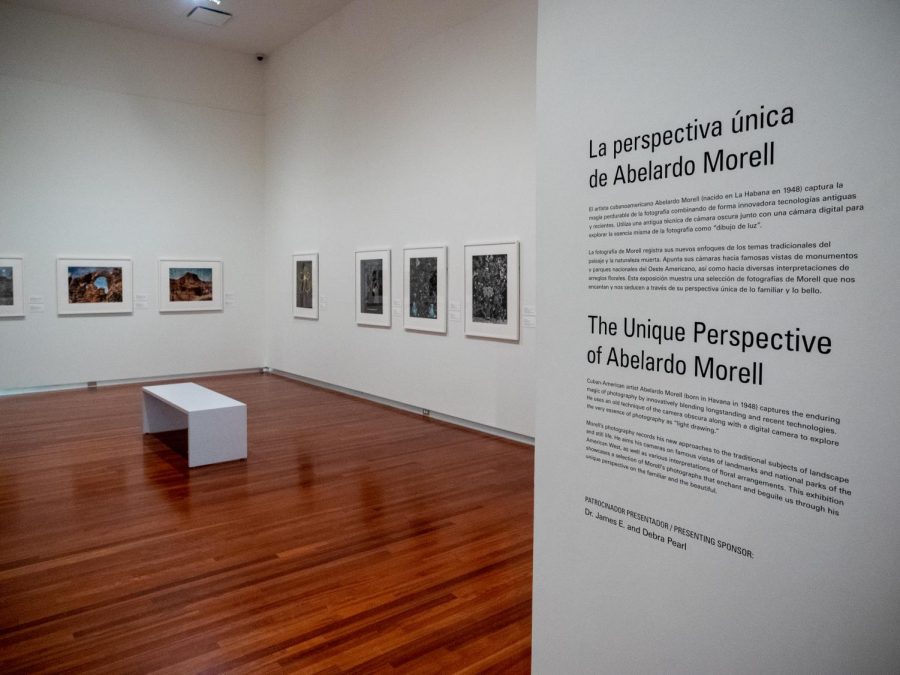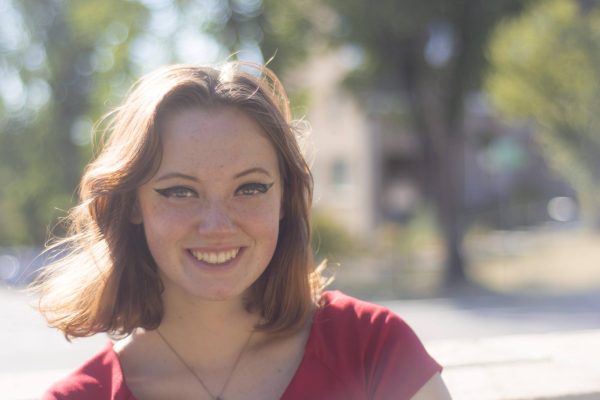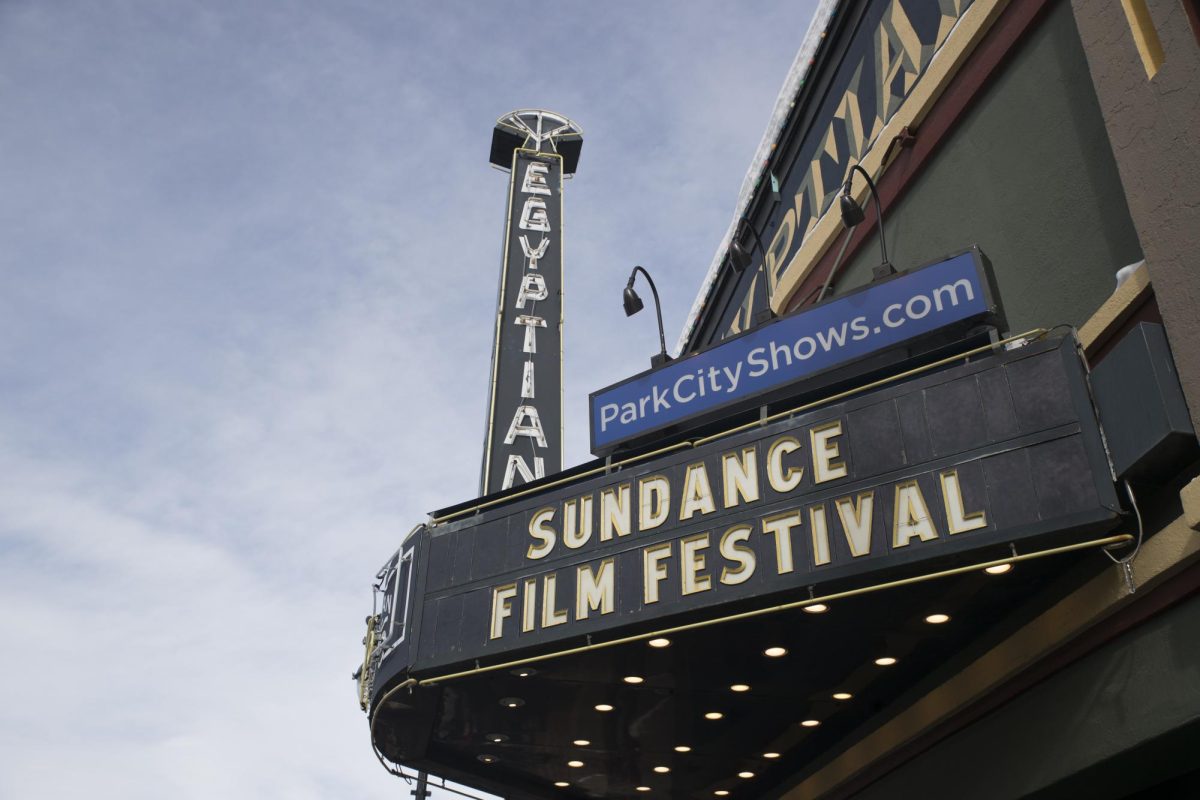Abelardo Morell Provides Exactly What is Promised in His New Exhibit
“The Unique Perspective of Abelardo Morell” exhibition on display at the Utah Museum of Fine Arts in Salt Lake City on Tuesday, April 11, 2023. (Photo by Jack Gambassi | The Daily Utah Chronicle)
April 12, 2023
On March 4, 2023, the Utah Museum of Fine Arts opened an exhibit entitled “The Unique Perspective of Abelardo Morell,” which features 14 photographs highlighting nature, floral stills and, at times, himself. Morell’s methods are a beautiful meld between traditional subjects and modern techniques that redefine photography as an art form.
Layered Landscapes
Many of Morell’s pieces are layered landscapes that capture two sides of nature, one being the recognizable image of the location and the other often being the ground or a nearby road. In “Tent-Camera Image on Ground: View of Garnet Hill, Yellowstone National Park, Wyoming,” Morell captures what appears to be a small group of burnt trees in the wintertime. However, he overlays it across an asphalt road, forcing the viewer to see a completely different side of the natural landscape. It provides an illusion that makes the picture of the trees look like an intricate pattern melted into snow on a road, but it also brings to mind the man-made roads carved through the previously unadulterated land.
The same can be found in “Tent-Camera Image on Ground: Grand Tetons and Snake River on Sidewalk.” The overlay of the sidewalk, beautiful mountain range and river makes it look like a framed photograph reflecting concrete in its glass covering. The X across the photo draws the eye into an unexpected focal point but ends up forcing the viewer to find their own path across the rest of the picture, as there isn’t a traditional compositional line that leads the eye around. The tiny stones in the concrete also give the piece a beautiful painterly look emblematic of Georges Seurat.
One of the pieces in which the overlaid ground and the background landscape meld the most is “Tent-Camera Image on Ground: The Colorado River Looking Northwest Moab, Utah.” There’s a beautiful harmony between the dry, wood chip-covered ground and the damp red rock beside a river that allows the viewer to see all three images: the actual river, the desert floor and the meshing of both.
Flowers Forcing Perspective
Four pieces from Morell’s “Flowers for Lisa” series are featured in the exhibit. They are all starkly different from any of the tent-camera pieces. “Flowers for Lisa #75” was not the piece that caught my attention initially, but as soon as I saw it my jaw dropped. It was the first photograph I saw that had a human subject in it, and the focal point was not a real flower, but rather a light painting that was drawn using a colored flashlight and prolonged exposure from the camera lens. It feels like a contrast between Morell’s art and traditional symbols of love: he’s giving a flower to Lisa, but it’s something of his own creation and therefore even more meaningful to him. The man (who we can assume to be Morell) is out of focus, forcing the viewer to see his creation standing strong in front of him while it simultaneously obscures him.
The other standout “Flowers for Lisa” piece is #36. The only two elements of the photograph are the shadow of a vase of flowers, overlapping over a white door that is blocking a bright light. The complete lack of nature depicted gives the feeling of loneliness and emptiness that stands out in the gallery of otherwise very busy photographs. Morell creates a beautiful contrast between geometric and organic shapes with the perfectly rectangular door and the floral shadow bursting from its perimeter.
Methods to Morell’s Madness
Morell’s photography techniques are nothing short of unique. In an interview with Musée Magazine in Issue 15: Place, Andrea Blanch dug into the way Morell creates his art. He was heavily inspired by camera obscuras and how much they affected people in the ’80s.
“I knew there was something really powerful about that phenomenon,” Morell said. “So in ’91, I thought, ‘Why not try to make a picture of that effect?’ … People have used pinhole cameras, but a photograph inside a room converted into a camera obscura and photographed, no one had done that before for some reason.”
He started out darkening a whole room with opaque plastic, then made a tiny hole in the plastic looking outdoors so a dim image of the outside would show onto the opposite wall. It required a long exposure to get enough light into the picture, sometimes as long as eight hours.
As his techniques have developed, he has found the way to capture his images exactly as he wants: the tent camera.
“The tent camera is sort of an outgrowth of the camera obscura technique,” Morell said. “I had a commission to do work in West Texas a couple of years ago and they were wondering if I could do camera obscura pictures in the desert, and I pointed out that there are no rooms in the desert, so no, I can’t do it. So I thought about making a portable room in the form of a tent. And I continued to make work in that way too.”
Morell’s methods are constantly developing and shifting with the times, but no matter how he uses his camera, his photographs continue to shift viewer’s perspectives on what photography can be as an art form.













